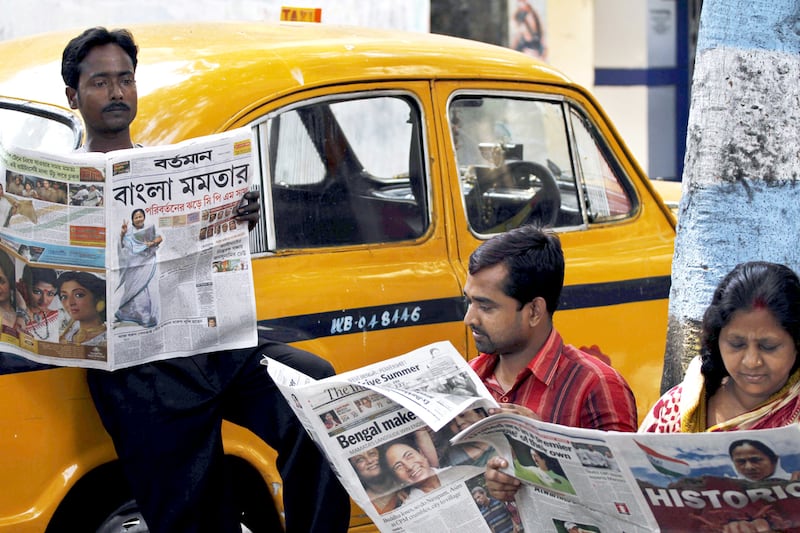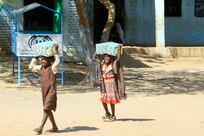The first film V K Neelarao directed was Hedde Jomai, or "Idiot Son-in-Law". It was released in 2013, when he was 69 years old. He produced it himself, found a few theatres to screen it in his home city of Madurai and three neighbouring towns in Tamil Nadu. It ran for a week in each place.
The audiences weren't massive, but then again, they couldn't have been. Hedde Jomai was made in Saurashtran — a language distinct from that spoken in the region of Saurashtra, in the state of Gujarat. Mr Neelarao's Saurashtran is spoken by a small community of 200,000 people, whose ancestors came from Gujarat to the south Indian state of Tamil Nadu 800 years ago.
Mr Neelarao fears his language is dying. He made Hedde Jomai for the same reason he says he has been writing articles, plays and poems in Saurashtran all these years: to convince the people in his community to speak Saurashtran in its pure form again.
“They learned Tamil in schools, and then they started speaking it more commonly,” he said. “In school, we had to read and write Tamil. There was no scope for speaking Saurashtran to too many people, or to read it. Slowly, the language started eroding. Maybe 20 per cent of us speak Saurashtran now.”
Saurashtran is only one of the hundreds of fraying threads in India’s rich linguistic tapestry. At the moment, Indians speak at least 780 languages, according to the People’s Linguistic Survey of India (PLSI), a volunteer-driven effort that is compiling 50 volumes of information on these languages.
Roughly 250 languages have vanished over the past 50 years, and another 400 are at the risk of dying in the next 50, said Ganesh Devy, the chairman of PLSI. “The situation is very frightening.”
On Thursday, Dr Devy’s team released the latest set of 11 volumes in the survey, adding to the 22 volumes published so far.
Between 2010 and 2013, the 3,500 volunteers of the PLSI spread across the country, cataloguing languages. They collected songs and their translations, they asked about the words for colour and the terms used to denote space and time, and they summarised the history and geography of the region where these languages were spoken. The cost of this project, Dr Devy said, was around 20 million rupees (Dh1.15 million)
The PLSI is the first survey of Indian languages since George Grierson, an administrator in British India, completed his own in 1928.
Dr Devy said his team did not worry about the intricacies of historical linguistics or language families. “That would mean losing our path in a jumble of languages,” he said. Instead, they focused on geographical distinctions and “accepted people’s claims when they called what they speak a language.”
In the hills of the state of Uttarakhand in the Himalayas, for instance, PLSI surveyors encountered a community that called its language “Rung”, and considered it to be different from Pahadi, Kumaoni and Garhwali, all established regional languages. So Rung features in the PLSI volumes as a separate language.
The preservation of languages is important, Dr Devy said, because “every language has a unique world view”. To lose a language, therefore, is to lose a distinct way of looking at the world.
Some of these languages wither, as in the case of Saurashtran, by being subsumed under more dominant languages. Others pass away with their speakers. In 2010, the death of an 85-year-old woman named Boa Senior in the Andaman Islands left no surviving speakers of a language called Aka-Bo.
Arup Kumar Nath, a linguistics scholar at the Centre for Endangered Languages in Tezpur University, remembers Aka-Bo well. When he was a graduate student at New Delhi’s Jawaharlal Nehru University, he worked on a project called Vanishing Voices of the Great Andamanese, trying to document, in audio and text, the structures and sounds of the islands’ languages.
Dr Nath now works in the north-eastern state of Assam, recording the languages that are dwindling there. He seeks out old people in villages who speak Assamese as well as their own language, and asks them to tell stories or sing songs. He also tries to unravel the structure of the languages and their histories. This documentation itself is part of the process of preservation, he believes.
“When people do not find anything written in their language, they will develop a kind of apathy for their language,” Dr Nath said. “They will feel their language is not being used in academia or in other institutions.”
Languages can be kept alive only with the help of documentation. “You need to have grammar books, dictionaries, story books, other narratives. Without that, you just cannot think of preserving a language.”
Dr Devy, however, thinks the disappearance of many minor languages is inevitable. Electronic devices are shouldering our burdens of memory, and the world is becoming more homogenous.
“But it’s a sad thought, because these languages are so beautiful — such lovely songs, such lovely stories. We have so much attachment towards them, because of the 70,000 years of our history of speech,” he said. “All of us will have to carry this forward, so that all our historical experience remains intact even in this next phase of the human species.”





